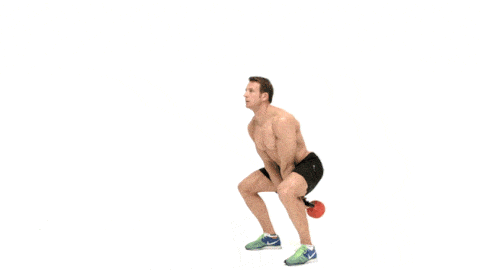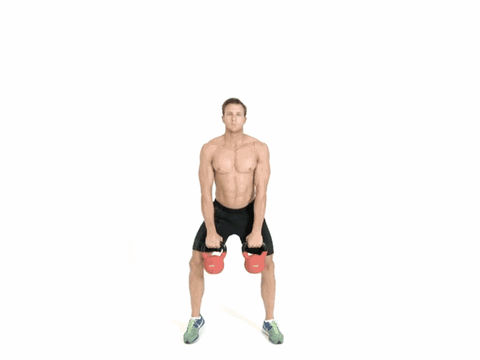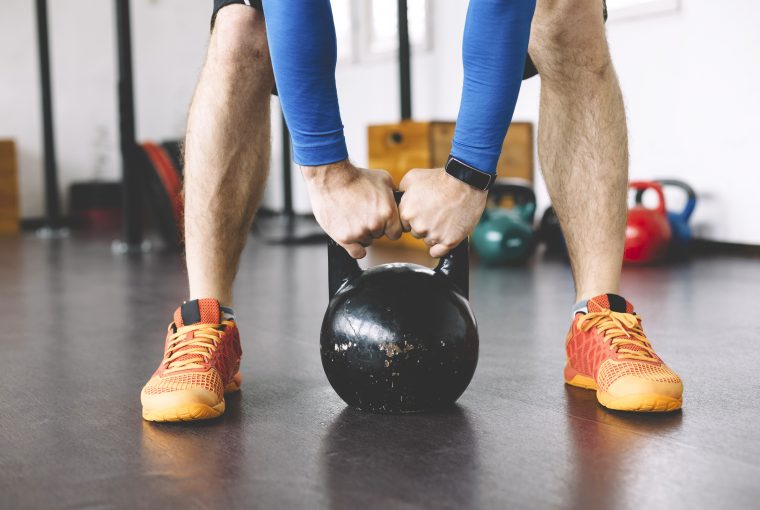The story of turning up to your gym and being devastated at the lack of equipment can be a very familiar one. All the dumbbells are gone, the bench covered in sweat and your favourite barbell is laying across the back of the gym floor’s loudest grunter.
Which gives you two possibilities: ditch the workout and go home or, preferably, find a piece of versatile equipment and make it your own for the best part of an hour.
That’s where the kettlebell comes into play. Packing the same weighty punch as dumbbells with half the popularity, it’s likely to be ignored while gym bros queue for the bench. In this article, we run down the best kettlebell exercises — in no particular order, mind — to burn fat, build muscle and increase fitness.
Kettlebells: An Introduction
Before we give you our most effective kettlebell workout, it’s time you got up to scratch on this versatile piece of kit. For most people, a lack of equipment in the gym introduces them to using kettlebells. Much like the humble rowing machine and versa climber, most gym bros steer clear of the cast-iron ‘bells, helping you get an effective, time-efficient workout in, without having to worry about your kit getting pinched. This and the growing popularity of sports such as CrossFit and Strongman have helped drive kettlebell training and workouts into the mainstream.
But it’s not always been this way. In the 19th century, circus strongmen used weights — original meant for weighing crops — to alter their physique, alongside training recreationally and for competition, which gradually saw kettlebell training rise in popularity.
On top of this, owing to their design, kettlebells are one of the easiest weights to move around during your workout in a short timeframe and can be stored away easily, from your car boot to your garden shed or garage. They’re adaptable to your strength and fitness levels, too. Fitness brands such as Rogue and Bulldog stock kettlebells that vary in weights and sizes — from 4kg in weight all the way up to a whopping 68kg.
Kettlebells vs Barbells
This is the basis of one of our most-asked questions at Men’s Health. Kettlebells or dumbbells? Kettlebells or barbells? Barbells or dumbbells? As with with your nutrition and your recovery, your training strategy depends on your overall goal.
Kettlebell training, however, could prove to be advantageous if you’re a member of a busy gym or want to avoid the weights room. Exercises such as the kettlebell swing can also help increase your heart rate — more than static, isolated moves can — to burn extra fat and improve core strength.
“KBs are best for swinging to develop your posterior chain. As these are your body’s biggest muscles, you’ll also torch calories,” says Rob Blair, PT at The Commando Temple.
Your Guide to Kettlebell Training
Similarly, kettlebells are an incredibly useful tool for those looking to build their base of strength and mobility. If you’re struggling with your barbell back squat, for example, utilising the kettlebell goblet squat (example below) is an ideal way of regressing the back squat to a safer exercise that can then be upgraded as your strength training progresses.
Well-suited for swings, presses and carries, kettlebells also lend themselves to more dynamic movements, where a dumbbell or barbell may be more difficult to use.
Benefits of Kettlebell Training
Usually, kettlebell workouts are built on a high-rep range, meaning that several muscles are worked at once and, if kept at a consistent pace, can offer similar aerobic benefits to HIIT training. During a 2010 study, participants performed a 20-minute kettlebell snatch workout and were found to burn 13.6 calories a minute during the entirety of the workout, equating to “running a 6-minute mile pace”.
Similarly, by performing kettlebell circuits three times a week, you’ll pump up your VO2 max by 6% in just under a month, according to the NSCA’s TSAC Report. Using kettlebells, you can also improve your strength, cardio, stability, power, endurance and balance.
The Journal of Strength and Conditioning Research also found that kettlebell training contributes to a healthier lower back, owing to the loading and movement patterns.
Kettlebell Training: An Expert’s Opinion
“Kettlebells are arguably one of the most versatile bits of equipment you can find in a gym,” says Sam Wardingley, a London Bridge-based PT. “They’re great tools for metabolic conditioning and can be used for resistance work too, if you can’t access dumbbells or barbells.”
Injury Risk
“The most common injury that occurs using a kettlebell is in the lower back,” explains Wardingley. “Typically, it’s with the kettlebell swing, because of its dynamic nature – moving back and forth quickly at the hip joint”. It doesn’t end there.
“This exaggerated flexion and extension at the hip puts a lot of force through the lower back.” When it comes to getting injuries from poor form, the “arching of the back and not engaging the glutes in an overhead press or folding in a goblet position” can put you at risk of busting your lower back.

1. Kettlebell Swing
How?
1. Stand with feet set wider than shoulder-width and bend your knees to grab the kettlebell with both hands.
2. Drive your hips, keep your back flat swing the weight up to shoulder height.
3. Return to the start position and repeat without losing momentum.
Why?
Initiated by a powerful hip thrust from your hamstring and glutes, opting for heavier weights (once the move is mastered, of course) for up to 90 seconds a set will vastly improve your anaerobic fitness, accelerating your heart-rate and ignite a fat-burn that the bench press can only dream of.

2. Kettlebell Thrusters
How?
1. Hold two kettlebells by their handles so the weight is resting on the back of your shoulders.
2. Slightly bend your knees and squat down, keeping your legs in line with your shoulders.
3. Drive through your legs and straighten them, extending your arms as you do to raise the kettlebells above your head.
4. Squat down and repeat.
Why?
As one of the most criminally under-rated full-body moves, the punishingly effective thruster offers a full-body blitz that other moves can’t even get near.
A move reserved for CrossFit zealots, this is not. Instead, by combining a front squat with an overhead press, you’re transforming a drab move into a compound, multi-joint exercise that demands full-body power.

3. Kettlebell Clean and Press
How?
1. Stand holding two kettlebells by your thighs, knees slightly bent and legs shoulder-width apart.
2. In one swift movement, slightly jump off the ground and raise your arms to extend above your head.
3. Land softly on your feet with your knees bent as though you’re doing a squat and extend your arms straight above you shoulder-width apart.
Why?
Powerlifting moves needn’t be restricted to barbells bending under crippling weight loads. Instead, the kettlebell clean and press offers the opportunity to increase grip strength, become stronger in overhead movements (your shoulder press will thank you) and will help you learn the lesson of maintaining a rigid core during all lifts.
4. Kettlebell Snatch
How?
1. Holding a kettlebell in one hand between your legs, squat down until your thighs are parallel to the floor.
2. Drive upwards through your hips and knees and as the kettlebell rises to shoulder height, rotate your hand and push it upwards until your arm is locked out.
3. Squat down and return the weight to the start position. Repeat with one arm, then swap sides.
Why?
Studying the benefits of the kettlebell snatch, the University of Wisconsin found that participants burned around 20kcals a minute while performing kettlebell snatches, during a work/rest split of 15 seconds on and 15 seconds off.
Plus, the researchers found that participants performing the kettlebell snatch usually maintained 86 to 99 per cent of their maximum heart rate, making it an essential move for easy weight loss.
5. Kettlebell Pistol Squat
How?
1. Hold one kettlebell with both hands just under your chin.
2. Lift one leg off the floor and squat down with the other.
3. Drive through the heel and bring yourself back up to standing position, without letting your leg touch the floor.
4. Lower back down and repeat.
Why?
Functional and an easy gym brag, the kettlebell pistol squat is the king of mobility moves.
Ideal for oiling the stiff joints of desk-jockeys and gym bros, it’ll also set your Instagram feed ablaze. Helping you master the holy trinity of fitness — stability, strength and mobility — it’ll challenge your core (there’s more to a six-pack than crunches and planks, after all) and will build sportive-worthy quads while increasing balance.

6. Kettlebell Goblet Squat
How?
1. Stand with your legs slightly wider than shoulder-width apart, clasping a kettlebell in each hand in front of your chest with palms facing each other.
2. Bend your knees and lower yourself into a squat, keeping the kettlebells in the same position and ensuring you don’t round your back by tensing your glutes throughout.
3. Drive back up and repeat.
Why?
When it comes to simple fat-burning, it’s hard to beat the squat.
As one of the royal compound moves (alongside the deadlift and the bench press), the kettlebell goblet squat builds huge lower-body strength and more powerful glutes that can be transferred to your deadlifts and your running technique.
7. Kettlebell Farmer’s Walk
How?
1. Hold two kettlebells by your side.
2. Keep your arms strong and walk short, quick steps as fast as possible.
3. Turn around and walk back.
Why?
Ideal for building grip and plugging onto the end of a tough workout, farmer’s walks also pack heavy-duty muscle onto your upper-back while fighting lower-back pain and being a useful conditioning tool and fat-loss. There’s nothing a kettlebell farmer’s walk can’t do.




